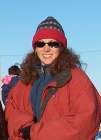 |
|
|
| Author |
Message |
Misty_Nikula-Ohlsen

Joined: 23 Mar 2004
Posts: 74
Location: Barrow, AK

|
 Posted:
Fri Jul 16, 2004 6:23 am Posted:
Fri Jul 16, 2004 6:23 am |
  |
I got up this morning to a lot of rain, so I got all of my warm and dry gear and met up with the wildlife group at the Atqasuk Hotel (like the NARL Hotel in Barrow, but smaller).
Since it was so rainy, the visibility wasnít very good, so we waited for it to clear while Bill spent a lot of time on the phone trying to get weather reports from Point Lay. Point Lay is on the coast, near the Chukchi Sea. The wildlife group knew that there were a lot of geese there, but we needed to be sure it was safe to fly there. They wanted to band a total of about 1000 geese. There are an estimated 200,000 white-front geese in all of Alaska, so this is only a small percentage (What percentage is it?).
Finally, at about 10:45, we walked down to the airstrip and got the planes ready. I helped by pumping out the floats. We decided to fly south as that was the clearest direction. The area to the west looked the nastiest. We flew about 20-30 miles south and began looking for lakes with birds. Ed looked around a bit with us and then headed back to Atqasuk because there was worry that the weather would close in on the town behind us.
We found a couple different lakes with about 100-150 birds in each. Bill also located a lake with about 150 birds and we were circling them while we made decisions. We saw a lot of caribou tracks in the marshy areas surrounding the lakes.

Caribou tracks
Ed called on the radio from Atqasuk and told us that the weather was closing in. The visibility was getting down to one mile or so and the ceiling (cloud level) was less than 400 feet. We decided to head in. Even though the weather was good where we were, we didnít want to get caught out in the field and be unable to get back into Atqasuk.
By the time we got back to town about 15 minutes later, the visibility was getting much worse and the rain was getting heavier. It didnít look like it was going to get any better anytime soon, so we called it a day and headed back into town to check the weather reports for tomorrow.

Weather turns ugly
Since the weather reports didnít look promising for the next few days and it might be at least day or two until they could get out again, I decided that I should get back to Barrow. Hageland wasnít flying due to mechanical problems, so I made a reservation with Cape Smythe Air for the 4 pm flight out of Atqasuk.
The Hotel cook lent us a truck and Bill was kind enough to drive me down to the airstrip to meet the plane. Little did he know what he had gotten himself in for! We waited until 5 pm and still no plane showed up. Mel Wong, a neighbor from the village, finally found out on the radio that the plane had not even left Barrow yet! So we headed back to the Hotel and I called Cape Smythe. The woman at the desk said that they were going to be leaving in about 5 minutes and would be in Atqasuk at 5:45. I called to double check at 5:25 and she said that they were boarding. So we headed back out to the airstrip at 5:40. By 6:30 we were really starting to wonder again. Mel showed up again and said the ETA was 6:40. FINALLY, at about 6:55, the plane showed up! They unloaded a lot of mail and packages and I loaded up for the 25 minute trip back to Barrow.

Bye-bye Atqasuk!
One thing that I have learned is that travel on the North Slope is weather dependent and schedules are only suggestions. 
Cool Bird Facts
Here are some somewhat random, but interesting facts about birds that I learned from Bill as we sat in the truck for 2 hours:
-- Birds, like geese, where both sexes look similar generally co-parent their young, that is the male and female work together to build the nest and raise the brood. Bird species where the males are much more brightly colored than the females, like ducks, tend to only have the females raise the young. Having a brightly colored male bird around would certainly attract more attention to the nest area, so it is actually beneficial for the brood for the male to depart (he also eats a lot of the food in the nearby area, much like in humans  ). ).
-- Co-parenting breeding pairs, like geese, swans, loons, etc, generally keep the same mates from season to season. This is commonly referred to as ďmating for lifeĒ. BUT it does not mean that if one of the pair dies that the other one never breeds again. Typically, the surviving partner would not breed again that season, but the next season it would certainly find a new mate. Otherwise, there would be a LOT fewer geese around.
-- Migratory birds may have separate winter and summer grounds, but many also have separate breeding and molting grounds. Often as soon as babies can fend for themselves, the parents leave for the molting ground. Sometimes the babies follow right away, other times they just skip the molting ground (since they donít molt in the first year anyway) and go directly to the wintering grounds. How they know where that is, I have no idea.
-- All of the spectacled eiders in the entire world (about 400,000) winter in one area of the Bering Strait near St. Lawrence Island. There is an area there where the currents from the Arctic and Pacific meet in such a way that there are loads of plankton and thus tons of tiny bivalves, which the birds eat. The birds dive nearly 60 m (~190 ft) to the bottom to eat the clams. Then in the spring they head to tundra areas all around the Arctic to breed.
THANKS!
I would like to take this opportunity to publicly thank Bill Larned for asking me to join the US Fish and Wildlife group and giving me the opportunity to work with them. It was a tremendous experience and one that I will probably not get again. He is a very knowledgeable biologist and I appreciate his willingness to share his 25 years of wildlife work experiences with me while we sat waiting for the plane.
Thanks also to Julian, Heather and Dennis for being very patient with all of my questions about bird banding and their work.
I would also like to thank Paul Anderson. He was a terrific pilot, who not only gave me some awesome views of the tundra and goose herding, but I would also like to thank him for giving me the incredible opportunity to try my hand at flying a small plane. It was an amazing experience. Thanks! |
|
|
     |
 |
|
|
|
View next topic
View previous topic
You cannot post new topics in this forum
You cannot reply to topics in this forum
You cannot edit your posts in this forum
You cannot delete your posts in this forum
You cannot vote in polls in this forum
You cannot attach files in this forum
You can download files in this forum
|
Powered by phpBB 2.0.11
© 2001, 2002 phpBB Group :: FI Theme ::
All times are GMT
| |
